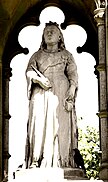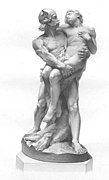Template:Did you know nominations/William John Seward Webber
- The following is an archived discussion of the DYK nomination of the article below. Please do not modify this page. Subsequent comments should be made on the appropriate discussion page (such as this nomination's talk page, the article's talk page or Wikipedia talk:Did you know), unless there is consensus to re-open the discussion at this page. No further edits should be made to this page.
The result was: promoted by Theleekycauldron (talk) 01:15, 7 December 2021 (UTC)
| DYK toolbox |
|---|
William John Seward Webber
... that Queen Victoria (pictured), as sculpted by William John Seward Webber in Harrogate's Jubilee Memorial, wears the Koh-i-Noor diamond in her necklace?Source: "Unveiling the statue of Queen Victoria at Harrogate", Leeds Mercury, 7 October 1887: "This is a statue of the Queen in white marble ... Her necklace contains the famous Koh-i-Noor."
- Reviewed: Thomas Guggeis
- Comment: This article was created over about 5 months in userspace, then copied and pasted to mainspace on 16 November. As far as I am aware, Queen Victoria never wore the Koh-i-Noor set in a necklace, though she did wear it set in a brooch and in a circlet (headdress). So the necklace with the Koh-i-Noor in this sculpture is probably artistic licence.
Created by Storye book (talk). Self-nominated at 16:10, 17 November 2021 (UTC).
 Captivating storey of a life and career, meticulously referenced on plenty of fine sources, offline sources accepted AGF, no copyvio obvious. The image is licensed. The hook works, but I don't see the diamond in the image. I am willing to approve it but would like to discuss other options:
Captivating storey of a life and career, meticulously referenced on plenty of fine sources, offline sources accepted AGF, no copyvio obvious. The image is licensed. The hook works, but I don't see the diamond in the image. I am willing to approve it but would like to discuss other options:
- mention the artistic license, because I didn't know the detail of her not wearing that gem in a necklace
- don't mention the diamond detail, focus on the jubilee, and use the second image from the gallery which show the greatness of the design better than the head detail
- base a hook on the Warrior/Youth work which I find much more attractive as an artwork, and as an image in small size ;)
- Let me know. Take that article to GA please, I think it's ready. - Graham87, can you please do the history merge for him? --Gerda Arendt (talk) 06:57, 18 November 2021 (UTC)
- @Gerda Arendt: I didn't do the history merge because it's not needed. Graham87 09:41, 18 November 2021 (UTC)
- @Gerda Arendt: Thank you for the review. Diamonds were often cut in cabochon style in the 19th century and earlier. This one was cut with a flat bottom like all cabochons, and when viewed from above, it was a large oval, about 1.5 inches long. Modern cabochons usually have a smoothly rounded surface; this one was lightly faceted but the facets don't show on the sculpture. So it looks like half an egg, I suppose. The Koh-i-Noor is the large oval at the bottom of the picture.
- We have no specific citation for artistic licence - that is just a conclusion that we can probably make, since we have no evidence that Victoria ever had it set in a necklace. Therefore I cannot use "artistic licence" in a hook or in the article.
- I'll have a go at a hook using a full-length Victoria, and another hook using the Warrior and Wounded Youth sculpture. I'll come back shortly with those. Storye book (talk) 16:55, 18 November 2021 (UTC)
- ALT1:
... that Queen Victoria (pictured), in Harrogate's Jubilee Memorial, was carved in marble by the British sculptor William John Seward Webber and weighed 4.5 tons?Source: "Unveiling the statue of Queen Victoria at Harrogate", Leeds Mercury, 7 October 1887: "This is a statue of the Queen in white marble ... carved out of a block of Sicilian marble weighing 4½ tons ... The more striking feature of the statue ... is the faithful likeness of Her Majesty which the sculptor, Mr. Webber, has presented."
- ALT1:
- ALT2: ... that Warrior and Wounded Youth (pictured), was carved by the British sculptor William John Seward Webber while still a Royal Academy student? Source: Art in Devonshire by George Pycroft (1881): "Warrior and Wounded Youth ... The work was modelled by Mr. Webber whilst he was a student in the Royal Academy". Storye book (talk) 17:21, 18 November 2021 (UTC)
 I like both ALTs, ALT2 even better than ALT1. Up to prep builder. I think the pictured isn't really for the Queen in ALT1, but her sculpture, right? --Gerda Arendt (talk) 17:15, 26 November 2021 (UTC)
I like both ALTs, ALT2 even better than ALT1. Up to prep builder. I think the pictured isn't really for the Queen in ALT1, but her sculpture, right? --Gerda Arendt (talk) 17:15, 26 November 2021 (UTC)
- Thank you for the review. See ALT1a below. I have corrected it to refer to the statue (not Victoria herself) and have rephrased the same content, to keep it short.Storye book (talk) 18:08, 26 November 2021 (UTC)
- ALT1a: ... that the 4.5-ton, marble statue of Queen Victoria (pictured), in Harrogate's Jubilee Memorial, was carved by the British sculptor William John Seward Webber? Source: "Unveiling the statue of Queen Victoria at Harrogate", Leeds Mercury, 7 October 1887: "This is a statue of the Queen in white marble ... carved out of a block of Sicilian marble weighing 4½ tons ... The more striking feature of the statue ... is the faithful likeness of Her Majesty which the sculptor, Mr. Webber, has presented." Storye book (talk) 18:08, 26 November 2021 (UTC)
 , that's more to my liking, thank you! --Gerda Arendt (talk) 21:14, 26 November 2021 (UTC)
, that's more to my liking, thank you! --Gerda Arendt (talk) 21:14, 26 November 2021 (UTC)
- ALT2: ... that Warrior and Wounded Youth (pictured), was carved by the British sculptor William John Seward Webber while still a Royal Academy student? Source: Art in Devonshire by George Pycroft (1881): "Warrior and Wounded Youth ... The work was modelled by Mr. Webber whilst he was a student in the Royal Academy". Storye book (talk) 17:21, 18 November 2021 (UTC)
ALT1a to T:DYK/P6


